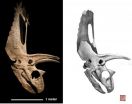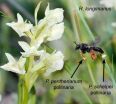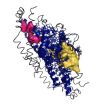(Press-News.org) The ability of some forms of plankton and bacteria to build an extra natural layer of nanoparticle-like armour has inspired chemists at the University of Warwick to devise a startlingly simple way to give drug bearing polymer vesicles (microscopic polymer based sacs of liquid) their own armoured protection.
The Warwick researchers have been able to decorate these hollow structures with a variety of nanoparticles opening a new strategy in the design of vehicles for drug release, for example by giving the vesicle "stealth" capabilities which can avoid the body's defences while releasing the drug.
Advances in polymerisation have led to a surge in the creation of vesicles made from polymer molecules. Such vesicles have interesting chemical and physical properties which makes these hollow structures potential drug delivery vehicles.
The University of Warwick team were convinced that even more strength, and interesting tailored properties, could be given to the vesicles if they could add an additional layer of colloidal armour made from a variety of nanoparticles.
Lead researcher on the University of Warwick team Associate Professor Stefan Bon said:
"We took our inspiration from nature, in how it adds protection and mechanical strength in certain classes of cells and organisms. In addition to the mechanical strength provided by the cytoskeleton of the cell, plants, fungi, and certain bacteria have an additional cell wall as outermost boundary. Organisms that particularly attracted our interest were those with a cell wall composed of an armour of colloidal objects – for instance bacteria coated with S-layer proteins, or phytoplankton, such as the coccolithophorids, which have their own CaCO3-based nano-patterned colloidal armour"
The Warwick researchers hit on a surprisingly simple and highly effective method of adding a range of different types of additional armour to the polymer based vesicles. One of those armour types was a highly regular packed layer of microscopic polystyrene balls.
This configuration meant the researchers could design a vesicle which had an additional and precise permeable reinforced barrier for drug release, as a result of the crystalline-like ordered structure of the polystyrene balls.
The researchers also succeeded in using the same technique to add a gelatine-like polymer to provide a "stealth" armour to shield vesicles from unwanted attention from the body's immune system while it slowly released its drug treatment.
This particular coating (a poly((ethyl acrylate)-co-(methacrylic acid)) hydrogel) absorbs so much surrounding water into its outer structure that it may be able to fool the body's defence mechanism into believing it is in fact just water.
The Warwick researchers had the idea of simply giving their chosen colloidal particles, or latex, based armour the opposite charge to that of the polymer vesicles, to bind them together. This turned out to be even more effective and easy to manipulate and tailor than they even they had hoped for.
However the researchers needed a new way of actually observing the vesicles to see if their plan had worked. Previous observational methods required researchers to dry out the vesicles before examining then under an electron microscope – but this seriously deformed the vesicles and thus provide little useful data. However the University of Warwick had recently acquired a cryo electron microscope thanks to funding from the Science City programme. This allowed the research team to quickly freeze the vesicles to -150 degress centigrade preserving the vesicles shape before observation by the electron microscope. This revealed that the researchers' simple charge based method had worked exactly as planned.
INFORMATION:
The research has just been published in a paper entitled Polymer Vesicles with a Colloidal Armor of Nanoparticles by Rong Chen, Daniel J. G. Pearce, Sara Fortuna, David L. Cheung, and Stefan A. F. Bon*Department of Chemistry, University of Warwick in the current Journal of the American Chemical Society http://dx.doi.org/10.1021/ja110359f
For further information please contact:
Dr.ir. Stefan A. F. Bon, Department of Chemistry
University of Warwick, CV4 7AL, UK
Tel: (+44) (0)24 76 574009
S.bon@warwick.ac.uk
Peter Dunn, Head of Communications, Communications Office,
University of Warwick, Coventry, CV4 8UW, United Kingdom
Tel: (+44) (0)24 7652 3708 Mobile: (+44) (0)7767 655860
email: p.j.dunn@warwick.ac.uk
Plankton inspires creation of stealth armor for slow-release microscopic drug vehicles
2011-02-01
ELSE PRESS RELEASES FROM THIS DATE:
The changing roles of 2 hemispheres in stroke recovery
2011-02-01
Milan, Italy, 31 January 2010 – Most people who survive a stroke recover some degree of their motor, sensory and cognitive functions over the following months and years. This recovery is commonly believed to reflect a reorganisation of the central nervous system that occurs after brain damage. Now a new study, published in the February 2011 issue of Elsevier's Cortex, sheds further light on the recovery process through its effect on language skills.
For almost all right-handed people and for about 60% of left-handers, damage to the left side of the brain causes a condition ...
Young rats given polyphenols show less endothelial function deterioration with aging
2011-02-01
The endothelium is the inner lining of our blood vessels and normal functions of endothelial cells include enabling coagulation, platelet adhesion and immune function. Endothelial dysfunction is associated with reduced anticoagulant properties and the inability of arteries and arterioles to dilate fully.
The gradual decrease in endothelial function over time is a key factor in the development of diseases associated with ageing, especially cardiovascular disease (CVD). Many epidemiologic studies suggest protection against CVD from moderate intake of alcoholic beverages, ...
Recalled ICD leads fail in women, youths most often
2011-02-01
The recalled Sprint Fidelis implantable cardioverter-defibrillator (ICD) leads (Medtronic) failed more often in younger patients, women, and individuals with hereditary heart disease, according to a multicenter study published online Jan. 17 in Circulation. The researchers found that lead failure was not associated with death or serious injuries.
However, about half of the patients whose leads fractured experienced painful inappropriate shocks, according to lead author Robert G. Hauser, MD, of the Minneapolis Heart Institute® at Abbott Northwestern Hospital. In a previous ...
Scientists find key protein that suppresses prostate cancer growth in the laboratory
2011-02-01
Cancer researchers have discovered an important protein, produced naturally inside cells, that appears to suppress the growth of prostate cancer cells in the laboratory. The findings, published tomorrow in the journal Cancer Research, offer promising leads for research towards new treatments.
Prostate cancer is the most common cancer among men in the UK, with 37,500 men diagnosed with the disease every year. Many prostate cancers are slow growing, but in some cases the cancer is aggressive and spreads to other parts of the body, such as the bone. These cases are much ...
Boys will infect boys, swine flu study shows
2011-02-01
Boys predominantly pass on flu to other boys and girls to girls, according to a new study of how swine flu spread in a primary school during the 2009 pandemic, published today in the journal Proceedings of the National Academy of Sciences. The results also suggest that flu transmission is most intensive between children of the same class, but that sitting next to an infected person does not significantly increase a child's risk of catching flu. The data will help researchers to model how epidemics spread and how interventions such as school closures can help contain an ...
Newly discovered dinosaur likely father of Triceratops
2011-02-01
New Haven, Conn.—Triceratops and Torosaurus have long been considered the kings of the horned dinosaurs. But a new discovery traces the giants' family tree further back in time, when a newly discovered species appears to have reigned long before its more well-known descendants, making it the earliest known member of its family.
The new species, called Titanoceratops after the Greek myth of the Titans, rivaled Triceratops in size, with an estimated weight of nearly 15,000 pounds and a massive eight-foot-long skull.
Titanoceratops, which lived in the American southwest ...
Wealth of orchid varieties is down to busy bees and helpful fungi, says study
2011-02-01
Scientists have discovered why orchids are one of the most successful groups of flowering plants - it is all down to their relationships with the bees that pollinate them and the fungi that nourish them. The study, published tomorrow in the American Naturalist, is the culmination of a ten-year research project in South Africa involving researchers from Imperial College London, the Royal Botanic Gardens, Kew, and other international institutions.
The orchid family is one of the largest groups of flowering plants, with over 22,000 species worldwide. Today's research suggests ...
SRNL demonstrating low-energy remediation with patented microbes
2011-02-01
Using funding provided under the American Reinvestment and Recovery Act, the U.S. Department of Energy's Savannah River National Laboratory has launched a demonstration project near one of the Savannah River Site's former production reactor sites to clean up chemically contaminated groundwater, naturally.
A portion of the subsurface at the Site's P Area has become contaminated with chlorinated volatile organic compounds that are essentially like dry-cleaning fluid. SRNL and Clemson University have patented a consortium of microbes that have an appetite for that kind ...
Communication pathways within proteins may yield new drug targets to stop superbugs
2011-02-01
INDIANAPOLIS – A School of Science at Indiana University-Purdue University Indianapolis biophysicist has developed a new method to identify communication pathways connecting distant regions within proteins.
With this tool, Andrew J. Rader, Ph.D., assistant professor of physics, has identified a mechanism for cooperative behavior within an entire molecule, a finding that suggests that in the future it may be possible to design drugs that target anywhere along the length of a molecule's communication pathway rather than only in a single location as they do today. The discovery ...
Wild rainbow trout critical to health of steelhead populations
2011-02-01
CORVALLIS, Ore. – Genetic research is showing that healthy steelhead runs in Pacific Northwest streams can depend heavily on the productivity of their stay-at-home counterparts, rainbow trout.
Steelhead and rainbow trout look different, grow differently, and one heads off to sea while the other never leaves home. But the life histories and reproductive health of wild trout and steelhead are tightly linked and interdependent, more so than has been appreciated, a new Oregon State University study concludes.
The research could raise new challenges for fishery managers ...




